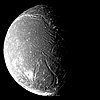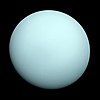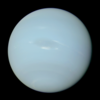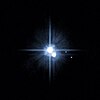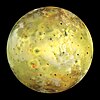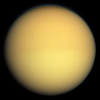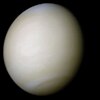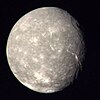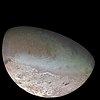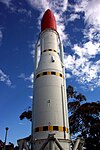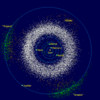Portal:Outer space/Selected article
This page is where the articles to be featured on the Outer space portal are listed. Feel free to make an entry for any article from Wikipedia:Featured articles#Physics and astronomy. It also contains an archive of Articles of the Month below.
Usage
[edit]The layout used to format these sub-pages is at Portal:Space/Selected article/Layout
- Add a new selected article to the next available subpage.
- Update
"max="to new total for its{{Random portal component}}on the main page.
Selected articles list
[edit]Selected article: 1-10
[edit]Portal:Outer space/Selected article/1
The International Space Station (ISS) is a space station, or a habitable artificial satellite in low Earth orbit. The ninth space station to be inhabited by crews, it follows the Soviet and later Russian Salyut, Almaz, and Mir stations, and America's Skylab. The ISS is a modular structure whose first component was launched in 1998. Now the largest artificial body in orbit, it can often be seen at the appropriate time with the naked eye from Earth. The ISS consists of pressurised modules, external trusses, solar arrays and other components. ISS components have been launched by American Space Shuttles as well as Russian Proton and Soyuz rockets. Budget constraints led to the merger of three space station projects with the Japanese Kibō module and Canadian robotics. In 1993 the partially built components for a Soviet/Russian space station Mir-2, the proposed American Freedom, and the proposed European Columbus merged into a single multinational programme. The ISS is arguably the most expensive single item ever constructed.
Portal:Outer space/Selected article/2
A dwarf planet is a celestial body orbiting the Sun that is massive enough to be spherical as a result of its own gravity but has not cleared its neighbouring region of planetesimals and is not a satellite. They are smaller than planets, but more massive than small solar system bodies. The term was adopted in 2006 by the International Astronomical Union (IAU) as a result of the increase in discoveries of trans-Neptunian objects that rivaled Pluto in size, and finally precipitated by the discovery of an even more massive object, Eris. The IAU currently recognizes five dwarf planets—Ceres (pictured), Pluto, Haumea, Makemake, and Eris. It is suspected that at least another 40 known objects in the Solar System are dwarf planets, but the number might be as high as 2,000. The 2006 definition has been both praised and criticized, and has been disputed by some scientists.
Portal:Outer space/Selected article/3
Planetary habitability is the measure of an astronomical body's potential for developing and sustaining life. It may be applied both to planets and to the natural satellites of planets. The only absolute requirement for life is an energy source (usually but not necessarily solar energy), but the notion of planetary habitability implies that many other geophysical, geochemical, and astrophysical criteria must be met before an astronomical body is able to support life. The idea that planets beyond Earth might host life is an ancient one, though historically it was framed by philosophy as much as physical science. The late 20th century saw two breakthroughs in the field. To begin with, the observation and robotic exploration of other planets and moons within the solar system has provided critical information on defining habitability criteria and allowed for substantial geophysical comparisons between the Earth and other bodies. The discovery of extrasolar planets—beginning in 1995 and accelerating thereafter—was the second milestone. It confirmed that the Sun is not unique in hosting planets and expanded the habitability research horizon beyond our own solar system.
Portal:Outer space/Selected article/4
The Hubble Deep Field is the result of a series of observations by the Hubble Space Telescope of a small region of the northern celestial hemisphere. It was assembled from 342 separate exposures taken with the Space Telescope's Wide Field and Planetary Camera 2 over 10 consecutive days between December 18 and December 28, 1995. The field is small enough that only a few foreground stars in the Milky Way lie within it; thus, almost all of the 3,000 objects in the image are galaxies, some of which are among the youngest and most distant known. By revealing such large numbers of very young galaxies, the HDF has become a landmark image in the study of the early universe, and it has been the source of almost 800 scientific papers since it was created. Three years after the HDF observations were taken, a region in the south celestial hemisphere was imaged in a similar way and named the Hubble Deep Field South. The similarities between the two regions strengthened the belief that the universe is uniform over large scales and that the Earth occupies a typical region in the universe (the cosmological principle).
Portal:Outer space/Selected article/5
Halley's Comet is the best-known of the short-period comets, and is visible from Earth every 75 to 76 years. Halley is the only short-period comet that is clearly visible to the naked eye, and thus, the only naked-eye comet that might appear twice in a human lifetime. Other naked-eye comets may be brighter and more spectacular, but will appear only once in thousands of years. Halley's returns to the inner Solar System have been observed by astronomers since at least 240 BC, and recorded by Chinese, Babylonian, and mediaeval European chroniclers, but were not recognised as reappearances of the same object. The comet's periodicity was first determined in 1705 by English astronomer Edmond Halley, after whom it is now named. It last appeared in the inner Solar System in 1986 and will next appear in mid-2061. During its 1986 apparition, Halley's Comet became the first to be observed in detail by spacecraft, providing the first observational data on the structure of the comet nucleus and the mechanism of coma and tail formation. These observations supported a number of longstanding hypotheses about comet construction, particularly Fred Whipple's "dirty snowball" model, which correctly surmised that Halley would be composed of a mixture of volatile ices, such as water, carbon dioxide and ammonia, and dust. However, the missions also provided data which substantially reformed and reconfigured these ideas.
Portal:Outer space/Selected article/6
The Space Shuttle Challenger disaster was a space disaster that occurred at 11:39 a.m. EST on January 28, 1986, when the NASA Space Shuttle Challenger disintegrated 73 seconds into its flight after an O-ring seal in its right solid rocket booster (SRB) failed. The seal failure caused a flame leak from the solid rocket booster that impinged upon the adjacent external propellant tank. Within seconds, the flame caused structural failure of the external tank, and the orbiter broke up abruptly due to aerodynamic forces. The shuttle was destroyed and all seven crew members were killed. The disaster resulted in a 32-month hiatus in the shuttle program and the formation of the Rogers Commission, a special commission appointed by President Ronald Reagan to investigate the accident. The Rogers Commission found that NASA's organizational culture and decision-making processes had been a key contributing factor to the accident. The Challenger disaster has been used as a case study in many discussions of engineering safety and workplace ethics.
Portal:Outer space/Selected article/7
The Kuiper belt is a region of the Solar System beyond the planets extending from the orbit of Neptune (at 30 AU) to approximately 50 AU from the Sun. It is similar to the asteroid belt, although it is far larger—20 times as wide and 20 to 200 times as massive. It consists mainly of small bodies, or remnants from the Solar System's formation. While the asteroid belt is composed primarily of rock, ices, and metal, the Kuiper objects are composed largely of frozen volatiles, such as methane, ammonia and water. The classical (low-eccentricity) belt is home to at least three dwarf planets: Pluto, Haumea, and Makemake. Some of the Solar System's moons, such as Neptune's Triton and Saturn's Phoebe, are also believed to have originated in the region. Since the belt was discovered in 1992, the number of known Kuiper belt objects has increased to over a thousand, and more than 70,000 KBOs over 100 km (62 mi) in diameter are believed to exist. Pluto is the largest known member of the Kuiper belt, if the scattered disc is excluded. In Pluto's honour, the four currently accepted dwarf planets beyond Neptune's orbit are called "plutoids".
Portal:Outer space/Selected article/8
The Shuttle–Mir Program was a collaborative space program between Russia and the United States, which involved American Space Shuttles visiting the Russian space station Mir, Russian cosmonauts flying on the shuttle and American astronauts engaging in long-duration expeditions aboard Mir. The program, under the code name 'Phase One', was intended to allow the United States to learn from Russian experience into long-duration spaceflight and to foster a spirit of cooperation between the two nations and their respective space agencies, NASA and RKA, in preparation for further cooperative space ventures. Announced in 1993 with the first mission occurring in 1994, the program continued until its scheduled completion in 1998, and consisted of eleven shuttle missions, a joint Soyuz flight and almost 1000 days in space for American astronauts over seven expeditions. The program was, however, marred by various concerns, notably the safety of Mir following a fire and collision on board the station, financial issues with the cash-strapped Russian Space Program and worries from astronauts about the attitudes of the program administrators. Nevertheless, a large amount of science, expertise in space station construction and knowledge in working in a cooperative space venture was gained from the combined operations, allowing 'Phase Two' of the joint project, the construction of the International Space Station, to proceed much more smoothly than otherwise possible.
Portal:Outer space/Selected article/9
Ariel is the brightest and third most massive of the 28 known moons of Uranus. Discovered on 24 October 1851 by William Lassell, it is named for a sky spirit in Alexander Pope's The Rape of the Lock and Shakespeare's The Tempest. Like its parent planet, Ariel orbits on its side, giving it an extreme seasonal cycle. As of 2011, almost all knowledge of Ariel derives from a single flyby of Uranus performed by the spacecraft Voyager 2 in 1986, which managed to image 35% of the moon's surface. There are no plans at present to return to study the moon in more detail. After Miranda, Ariel is the second-smallest of Uranus's five round satellites, and the second-closest to its planet. Among the smallest of the Solar System's 19 known spherical moons (it ranks 14th among them in diameter), Ariel is composed of roughly equal parts ice and rocky material. Like all of Uranus's moons, Ariel probably formed from an accretion disk that surrounded the planet shortly after its formation, and, like other large moons, it may be differentiated, with an inner core of rock surrounded by a mantle of ice. Ariel has a complex surface comprising extensive cratered terrain cross-cut by a system of scarps, canyons and ridges. The surface shows signs of more recent geological activity than other Uranian moons, most likely due to tidal heating.
Portal:Outer space/Selected article/10
Ceres is the smallest identified dwarf planet in the Solar System and the only one in the asteroid belt. It was discovered on 1 January 1801, by Giuseppe Piazzi, and for half a century it was classified as the eighth planet. It is named after Ceres, the Roman goddess of growing plants, the harvest, and motherly love. With a diameter of about 950 km (590 miles), Ceres is by far the largest and most massive body in the asteroid belt, and contains a third (32%) of the belt's total mass. Recent observations have revealed that it is spherical, unlike the irregular shapes of smaller bodies with lower gravity. The surface of Ceres is probably made of a mixture of water ice and various hydrated minerals like carbonates and clays. Ceres appears to be differentiated into a rocky core and ice mantle. It may harbour an ocean of liquid water underneath its surface. From the Earth, Ceres' apparent magnitude ranges from 6.7 to 9.3, and hence at its brightest it is still too dim to be seen with the naked eye. The unmanned Dawn spacecraft, launched on 27 September 2007 by NASA, was the first to explore Ceres after its arrival there in 2015.
Selected article: 11-20
[edit]Portal:Outer space/Selected article/11
Uranus is the seventh planet from the Sun; it is the third largest and fourth most massive planet in the Solar System. Uranus was the first planet discovered in modern times. Though it is visible to the naked eye like the five classical planets, it was never recognised as a planet by ancient observers due to its dimness. Sir William Herschel announced its discovery on March 13, 1781, expanding the known boundaries of the solar system. Uranus' atmosphere, although similar to Jupiter and Saturn in being composed primarily of hydrogen and helium, contains a higher proportion of "ices" such as water, ammonia and methane, along with the usual traces of hydrocarbons. It has the coldest planetary atmosphere in the solar system, with a minimum temperature of 49 K, and has a complex layered cloud structure in which water is thought to make up the lowest clouds, while methane makes up the uppermost layer of clouds. In 1986, images from the Voyager 2 space probe showed Uranus as a virtually featureless planet in visible light without the cloud bands or storms associated with the other giants. The wind speeds on Uranus can reach 250 m/s (560 mph).
Portal:Outer space/Selected article/12
Neptune is the eighth and farthest planet from the Sun in the Solar System. It is the fourth largest planet by diameter, and the third largest by mass. The planet is named after the Roman god of the sea. Discovered on September 23, 1846, Neptune was the first planet found by mathematical prediction rather than regular observation. Unexpected changes in the orbit of Uranus led astronomers to deduce the gravitational perturbation of an unknown planet. Neptune was found within a degree of the predicted position. The moon Triton was found shortly thereafter, but none of the planet's other 12 moons were discovered before the 20th century. Neptune has been visited by only one spacecraft, Voyager 2, which flew by the planet on August 25, 1989. Neptune is similar in composition to Uranus, and both have different compositions from those of the larger gas giants Jupiter and Saturn. This, Neptune and Uranus are typically classified “ice giants.” Traces of methane in the atmosphere, in part, account for the planet's blue appearance. At the time of the 1989 Voyager 2 flyby, its southern hemisphere possessed a Great Dark Spot comparable to the Great Red Spot on Jupiter. Neptune has a faint and fragmented ring system, which may have been detected during the 1960s but was only indisputably confirmed by Voyager 2.
Portal:Outer space/Selected article/13
Earth is the fifth-largest planet of the eight in the Solar System. It is also the largest, most massive, and densest of the Solar System's four terrestrial planets. Home to millions of species, including humans, Earth is the only place in the Universe where life is known to exist. The planet formed 4.54 billion years ago, and life appeared on its surface within a billion years. The world is expected to continue supporting life for another 0.5 billion years. Earth's outer surface is divided into several rigid segments that gradually migrate across the surface over periods of many millions of years. About 71% of the surface is covered with salt-water oceans, the remainder consisting of continents and islands. Earth's interior remains active, with a thick layer of relatively solid mantle, a liquid outer core that generates a magnetic field, and a solid iron inner core. Earth interacts with other objects in outer space, including the Sun and the Moon. The mineral resources of Earth, as well as the products of the biosphere, contribute resources that are used to support a global human population. The human inhabitants are grouped into about 200 independent sovereign states and have developed many views of the planet.
Portal:Outer space/Selected article/14
The Moon is Earth's only permanent natural satellite and the fifth largest moon in the Solar System. The average centre-to-centre distance from the Earth to the Moon is 384,403 kilometres (238,857 miles). The gravitational pull at its surface is about a sixth of Earth's. The Moon makes a complete orbit around the Earth every 27.3 days, and the periodic variations in the geometry of the Earth–Moon–Sun system are responsible for the lunar phases that repeat every 29.5 days. The gravitational, centripetal forces generated by the rotation of the Moon and Earth around a common axis, the barycentre, are largely responsible for the tides on Earth. The Moon is the only celestial body that humans have traveled to and landed on. The first artificial object to escape Earth's gravity and pass near the Moon was the Soviet Union's Luna 1, the first artificial object to impact the lunar surface was Luna 2, and the first photographs of the normally occluded far side of the Moon were made by Luna 3, all in 1959. The U.S. Apollo program has achieved the first (and only) manned missions to date, resulting in six landings between 1969 and 1972. Human exploration of the Moon ceased with the conclusion of the Apollo program, although as of 2024, several countries have announced plans to send either people or robotic spacecraft to the Moon.
Portal:Outer space/Selected article/15
Apollo 8 was the second manned mission of the Apollo space program. Commander Frank Borman, Command Module Pilot James Lovell and Lunar Module Pilot William Anders became the first humans to travel beyond Earth orbit and into an orbit around the Moon. It was also the first manned launch of the Saturn V rocket. NASA prepared for the mission in only four months. The hardware involved had only been used a few times—the Saturn V had only launched twice before, and the Apollo spacecraft had only just finished its first manned mission, Apollo 7. However the success of the mission paved the way for the successful completion of John F. Kennedy's goal of landing on the Moon before the end of the decade. After launching on December 21, 1968, the crew took three days to travel to the Moon, which they orbited for twenty hours. While in lunar orbit they made a Christmas Eve television broadcast that is thought to be one of the most watched of all time.
Portal:Outer space/Selected article/16
Jupiter is the fifth planet from the Sun and the largest planet within the Solar System. It is two and a half times as massive as all of the other planets in our Solar System combined. Jupiter, along with Saturn, Uranus, and Neptune, is classified as a gas giant. When viewed from Earth, Jupiter can reach an apparent magnitude of -2.8, making it the fourth brightest object in the night sky. The planet was known by astronomers of ancient times and was associated with the mythology and religious beliefs of many cultures. Jupiter is primarily composed of hydrogen with only a small proportion of helium; it may also have a rocky core of heavier elements. The outer atmosphere is visibly segregated into several bands at different latitudes, resulting in turbulence and storms along their interacting boundaries. A prominent result is the Great Red Spot, a giant storm that is known to have existed since at least the seventeenth century. Surrounding the planet is a faint planetary ring system and a powerful magnetosphere. There are also at least 67 moons, including the four large moons called the Galilean moons that were first discovered by Galileo Galilei in 1610. Jupiter has been explored on several occasions by robotic spacecraft, most notably during the early Pioneer and Voyager fly-by missions and later by the Galileo orbiter.
Portal:Outer space/Selected article/17
Laika was one of the Russian space dogs and the first living being to enter orbit, as a passenger on Sputnik 2, a Soviet spacecraft. Some classify her as the first animal to enter space, although other animals had entered space during sub-orbital flights on previous missions. Laika was found as a stray wandering the streets of Moscow, a female part-Samoyed terrier weighing approximately 6 kg (13 lb). Laika died on November 4, 1957, a few hours after launch, due to overheating, and her remains were destroyed during re-entry on April 14, 1958. Her true cause of death was not made public until years after the flight, with officials always stating that she was either euthanized by poisoned food or died when the oxygen supply ran out. Russian officials have since expressed regret for allowing Laika to die.
Portal:Outer space/Selected article/18
Mars is the fourth planet from the Sun and is known as the Red Planet due to its reddish appearance as seen from Earth. The planet is named after Mars, the Roman god of war. A terrestrial planet, Mars has a thin atmosphere and surface features reminiscent both of the impact craters of the Moon and the volcanoes, valleys, deserts and polar ice caps of Earth. It has the highest mountain in the Solar System, Olympus Mons, and the largest canyon, Valles Marineris. Mars' rotational period and seasonal cycles are also similar to those of the Earth. Of all the planets in the Solar System other than Earth, Mars is the most likely to harbor liquid water, and perhaps life. Mars is currently host to three functional orbiting spacecraft: Mars Odyssey, Mars Express, and Mars Reconnaissance Orbiter. This is more than any planet except Earth. The surface is also home to the two Mars Exploration Rovers (Spirit and Opportunity). Geological evidence gathered by these and preceding missions suggests that Mars previously had large-scale water coverage, while observations also indicate that small geyser-like water flows have occurred in recent years. Mars has two moons, Phobos and Deimos, which are small and irregularly shaped.
Portal:Outer space/Selected article/19
The Hubble Space Telescope is a space telescope that was carried into orbit by a Space Shuttle in 1990 and remains in operation. A 2.4-meter (7.9 ft) aperture telescope in low Earth orbit, Hubble's four main instruments observe in the near ultraviolet, visible, and near infrared. The telescope is named after the astronomer Edwin Hubble. Although not the first space telescope, Hubble is one of the largest and most versatile, and is well known as both a vital research tool and a public relations boon for astronomy. The HST was built by the United States space agency NASA, with contributions from the European Space Agency, and is operated by the Space Telescope Science Institute. Space telescopes were proposed as early as 1923. Hubble was funded in the 1970s, with a proposed launch in 1983, but the project was beset by technical delays, budget problems, and the Challenger disaster. When finally launched in 1990, scientists found that the main mirror had been ground incorrectly, compromising the telescope's capabilities. The telescope was restored to its intended quality by a servicing mission in 1993.
Portal:Outer space/Selected article/20
Pluto is the second-largest known dwarf planet in the Solar System and the tenth-largest body observed directly orbiting the Sun. Originally classified as the ninth planet from the Sun, Pluto was recategorized as a dwarf planet and plutoid owing to the discovery that it is only one of several large bodies within the Kuiper belt. Like other members of the belt, it is primarily composed of rock and ice and is relatively small; approximately a fifth the mass of the Earth's Moon and a third its volume. It has an eccentric orbit that takes it from 30 to 49 AU (4.4–7.4 billion km) from the Sun, and is highly inclined with respect to the planets. As a result, Pluto occasionally comes closer to the Sun than the planet Neptune. Pluto has five known moons, the largest being Charon, discovered in 1978, along with Nix and Hydra, discovered in 2005, and the provisionally named S/2011 (134340) 1, discovered in 2011, and S/2012 (134340) 1, discovered in 2012.
Selected article: 21-30
[edit]Portal:Outer space/Selected article/21
The definition of planet has included a wide range of celestial bodies. Early use of the term was never strict and its meaning has blurred to include or exclude a variety of objects. By the end of the 19th century, the word planet had a more firm definition: it applied only to objects in the Solar System, a number small enough that any differences could be dealt with on an individual basis. After 1992 however, astronomers began to discover many additional objects beyond the orbit of Neptune, as well as hundreds of extrasolar planets. These discoveries not only increased the number of potential planets, but expanded their variety and peculiarity. The issue of a clear definition for planet came to a head in 2005 with the discovery of the trans-Neptunian object Eris, a body larger than the smallest then-accepted planet, Pluto. In its 2006 response to the discovery, the International Astronomical Union released its decision on the matter. Its definition, which applies only to the Solar System, states that a planet is a body that orbits the Sun, is massive enough for its own gravity to make it round, and has "cleared its neighbourhood" of smaller objects around its orbit. Under this new definition, Pluto and the other trans-Neptunian objects do not qualify as planets.
Portal:Outer space/Selected article/22
Io is the innermost of the four Galilean moons of the planet Jupiter and, with a diameter of 3,642 kilometres (2,263 mi), the fourth-largest moon in the Solar System. It was named after the mythological character of Io, a priestess of Hera who became one of the lovers of Zeus. With over 400 active volcanoes, Io is the most geologically active object in the Solar System. This extreme geologic activity is the result of tidal heating from friction generated within Io's interior as it is pulled between Jupiter and the other Galilean satellites—Europa, Ganymede and Callisto. Several volcanoes produce plumes of sulfur and sulfur dioxide that climb as high as 500 km (300 mi) above the surface. Io's surface is also dotted with more than 100 mountains that have been uplifted by extensive compression at the base of the moon's silicate crust. Some of these peaks are taller than Earth's Mount Everest. Unlike most satellites in the outer Solar System, which are mostly composed of water-ice, Io is primarily composed of silicate rock surrounding a molten iron or iron sulfide core. Most of Io's surface is characterized by extensive plains coated with sulfur and sulfur dioxide frost. Io's volcanism is responsible for many of the satellite's unique features. Its volcanic plumes and lava flows produce large surface changes and paint the surface in various shades of yellow, red, white, black, and green, largely due to allotropes and compounds of sulfur. Numerous extensive lava flows, several more than 500 km (300 mi) in length, also mark the surface. The materials produced by this volcanism provide material for Io's thin, patchy atmosphere and Jupiter's extensive magnetosphere. Io's volcanic ejecta also produce a large plasma torus around Jupiter.
Portal:Outer space/Selected article/23
Saturn is the sixth planet from the Sun and the second largest planet in the Solar System, after Jupiter, with an average radius about nine times larger than the Earth's. Saturn is named after the Roman god Saturn, equated to the Greek Cronus (the Titan father of Zeus), the Babylonian Ninurta and the Hindu Shani. Saturn's astronomical symbol (♄) represents the Roman god's sickle. Along with Jupiter, Uranus and Neptune, Saturn is a gas giant. Together, these four planets are sometimes referred to as the Jovian planets, meaning "Jupiter-like". Saturn has a ring system that is divided into nine continuous and three discontinuous main rings (arcs), consisting mostly of ice particles with a smaller amount of rocky debris and dust. Sixty-two known moons orbit the planet; fifty-three are officially named. This does not include the hundreds of "moonlets" within the rings. Titan, Saturn's largest and the Solar System's second largest moon (after Jupiter's Ganymede), is larger than the planet Mercury and is the only moon in the Solar System to retain a significant atmosphere.
Portal:Outer space/Selected article/24
Ganymede is a moon of Jupiter and the largest moon in the Solar System. Completing an orbit in roughly seven days, it is the seventh moon and third Galilean moon from Jupiter. Ganymede participates in a 1:2:4 orbital resonance with the moons Europa and Io, respectively. It is larger in diameter than the planet Mercury but has only about half its mass. It has the highest mass of all planetary satellites with 2.01 times the mass of the Earth's moon. It is composed primarily of silicate rock and water ice, and a saltwater ocean is believed to exist nearly 200 km below Ganymede's surface. Ganymede is the only satellite in the Solar System known to possess a magnetosphere, likely created through convection within the liquid iron core. The satellite has a thin oxygen atmosphere that includes O, O2, and possibly O3. Ganymede's discovery is credited to Galileo Galilei, who observed it in 1610. The satellite's name was soon suggested by astronomer Simon Marius, for the mythological Ganymede, cupbearer of the Greek gods and Zeus's beloved.
Portal:Outer space/Selected article/25
Titan is the largest moon of Saturn, the only natural satellite known to have a dense atmosphere, and the only object other than Earth for which clear evidence of stable bodies of surface liquid has been found. Discovered on 25 March 1655 by the Dutch astronomer Christiaan Huygens, Titan is the sixth ellipsoidal moon from Saturn. Frequently described as a planet-like moon, it is the second-largest natural satellite in the Solar System, after Jupiter's moon Ganymede, and it is larger by volume than the smallest planet, Mercury. Titan itself is primarily composed of water ice and rocky material. Its dense, opaque atmosphere meant that little was known of the surface features or conditions until the Cassini–Huygens mission in 2004. Although mountains and several possible cryovolcanoes have been discovered, its surface is relatively smooth and few impact craters have been found. Owing to the existence of stable bodies of surface liquids and its thick nitrogen-based atmosphere, Titan has been cited as a possible host for microbial extraterrestrial life or, at least, as a prebiotic environment rich in complex organic chemistry.
Portal:Outer space/Selected article/26
Venus is the second planet from the Sun, orbiting it every 224.7 Earth days. It has no natural satellite. It is named after the Roman goddess of love and beauty. After the Moon, it is the brightest natural object in the night sky, reaching an apparent magnitude of −4.6, bright enough to cast shadows. Because Venus is an inferior planet from Earth, it never appears to venture far from the Sun: its elongation reaches a maximum of 47.8°. Venus reaches its maximum brightness shortly before sunrise or shortly after sunset, for which reason it has been referred to by ancient cultures as the Morning Star or Evening Star.
Venus is a terrestrial planet and is sometimes called Earth's "sister planet" because of their similar size, gravity, and bulk composition (Venus is both the closest planet to Earth and the planet closest in size to Earth). However, it has also been shown to be very different from Earth in other respects. It has the densest atmosphere of the four terrestrial planets, consisting of more than 96% carbon dioxide. The atmospheric pressure at the planet's surface is 92 times that of Earth's. With a mean surface temperature of 735 K (462 °C; 863 °F), Venus is by far the hottest planet in the Solar System. It has no carbon cycle to lock carbon back into rocks and surface features, nor does it seem to have any organic life to absorb it in biomass. Venus is shrouded by an opaque layer of highly reflective clouds of sulfuric acid, preventing its surface from being seen from space in visible light. Venus may have possessed oceans in the past, but these would have vaporized as the temperature rose due to a runaway greenhouse effect. The water has most probably photodissociated, and, because of the lack of a planetary magnetic field, the free hydrogen has been swept into interplanetary space by the solar wind.
Portal:Outer space/Selected article/27
Titania is the largest of the moons of Uranus and the eighth largest moon in the Solar System. Discovered by William Herschel in 1787, Titania is named after the queen of the fairies in Shakespeare's A Midsummer Night's Dream. Its orbit lies inside Uranus' magnetosphere. Titania consists of approximately equal amounts of ice and rock, and is likely differentiated into a rocky core and an icy mantle. A layer of liquid water may be present at the core–mantle boundary. The surface of Titania, which is relatively dark and slightly red in color, appears to have been shaped by both impacts and endogenic processes. It is covered by numerous impact craters reaching 326 km in diameter, but is less heavily cratered than the surface of Uranus' outermost moon, Oberon. Titania probably underwent an early endogenic resurfacing event that obliterated its older, heavily cratered surface. Like all major moons of Uranus, Titania probably formed from an accretion disk that surrounded the planet just after its formation. As of 2013, the Uranian system has been studied up close only once: by the spacecraft Voyager 2 in January 1986. It took several images of Titania, which allowed mapping of about 40% of the moon’s surface.
Portal:Outer space/Selected article/28
Mercury is the innermost planet in the Solar System. It is also the smallest, and its orbit is the most eccentric (that is, the least perfectly circular) of the eight planets. It orbits the Sun once in about 88 Earth days, completing three rotations about its axis for every two orbits. The planet is named after the Roman god Mercury, the messenger to the gods. Mercury's surface is heavily cratered and similar in appearance to Earth's Moon, indicating that it has been geologically inactive for billions of years. Due to its near lack of an atmosphere to retain heat, Mercury's surface experiences the steepest temperature gradient of all the planets, ranging from a very cold 100 K at night to a very hot 700 K during the day. Mercury's axis has the smallest tilt of any of the Solar System's planets, meaning that there are no seasons on its surface. Mercury and Venus can each make appearances in Earth's sky both as a morning star and an evening star (because they are closer to the Sun than the Earth), and at times Mercury can technically be regarded as a very bright object when viewed from Earth; however, its proximity in the sky to the Sun makes it more difficult to see than Venus.
Portal:Outer space/Selected article/29
The Sun is the spectral type G2V yellow star at the center of the Solar System. The Earth and many other bodies (including other planets, asteroids, meteoroids, comets and dust) orbit the Sun, which accounts for more than 99% of the Solar System's mass. Different latitudes of the Sun rotate at different rates; a point on the equator takes 25 days, while a point at a pole takes 36 days. The resultant torsion upsets the Sun's very strong magnetic field to create an 11-year solar cycle of activity. Heat and light from the Sun have supported almost all life on Earth. Humans use sunlight to grow crops (see photosynthesis) and power solar cells. The Sun is a ball of plasma with a diameter of 1.392 million km (864,950 mi) and a mass of about 2.0×1030 kg, which is somewhat higher than that of an average star. About 74% of its mass is hydrogen, with 25% helium, and the rest made up of trace quantities of heavier elements. The Sun is about 4.6 billion years old, and is about halfway through its main sequence evolution, during which nuclear fusion reactions in its core fuse hydrogen into helium.
Portal:Outer space/Selected article/30
Triton is the largest moon of the planet Neptune, discovered on October 10, 1846, by William Lassell. It is the only large moon in the Solar System with a retrograde orbit, which is an orbit in the opposite direction to its planet's rotation. At 2,700 km (1,700 mi) in diameter, it is the seventh-largest moon in the Solar System. Because of its retrograde orbit and composition similar to Pluto's, Triton is thought to have been captured from the Kuiper belt. Triton consists of a crust of frozen nitrogen over an icy mantle believed to cover a substantial core of rock and metal. The core makes up two-thirds of its total mass. Triton has a mean density of 2.061 g/cm3 (1.191 oz/cu in) and is composed of approximately 15–35% water ice. Triton is one of the few moons in the Solar System known to be geologically active. As a consequence, its surface is relatively young, with a complex geological history revealed in intricate and mysterious cryovolcanic and tectonic terrains. Part of its crust is dotted with geysers believed to erupt nitrogen.
Selected article: 31-40
[edit]Portal:Outer space/Selected article/31
The recorded history of Mars observation dates back to the era of the ancient Egyptian astronomers in the 2nd millennium BCE. Detailed observations of the position of Mars were made by Babylonian astronomers, and ancient Greek philosophers and Hellenistic astronomers developed a geocentric model to explain the planet's motions. Indian and Muslim astronomers estimated its size and distance from Earth. The first telescopic observation of Mars was by Galileo Galilei in 1610. The first crude map of Mars was published in 1840. When astronomers mistakenly thought they had detected the spectroscopic signature of water in the Martian atmosphere, the idea of life on Mars became popular. During the 1920s, the range of Martian surface temperature was measured; it ranged from −85 °C (−121 °F) to 7 °C (45 °F). The planetary atmosphere was found to be arid with only trace amounts of oxygen and water. Since the 1960s, multiple robotic spacecraft have been sent to explore Mars. The planet has remained under observation by ground and space-based instruments and the discovery of meteorites on Earth that originated on Mars has allowed laboratory examination of the chemical conditions on the planet.
Portal:Outer space/Selected article/32
Callisto is a moon of the planet Jupiter, discovered in 1610 by Galileo Galilei. It is the third-largest moon in the Solar System and the second largest in the Jovian system, after Ganymede. It is not a part of the orbital resonance that affects three inner Galilean satellites—Io, Europa and Ganymede—and thus does not experience appreciable tidal heating. Callisto rotates synchronously with its orbital period, so the same hemisphere is always turned toward Jupiter. It is composed of approximately equal amounts of rock and ices, with a mean density of about 1.83 g/cm3. Compounds detected spectroscopically on the surface include water ice, carbon dioxide, silicates, and organic compounds. Investigation by the Galileo spacecraft revealed that Callisto may have only partially differentiated interior covered by a thick icy crust and possibly a subsurface ocean of liquid water at depths greater than 100 km. Prominent surface features include multi-ring structures, variously shaped impact craters, and chains of craters and associated scarps, ridges and deposits. Callisto is surrounded by an extremely thin atmosphere composed of carbon dioxide and probably molecular oxygen, as well as by a rather dense ionosphere.
Portal:Outer space/Selected article/33
Black Arrow was a British satellite carrier rocket. Developed during the 1960s, it was used for four launches between 1969 and 1971. Its final flight was the first successful orbital launch to be conducted by the United Kingdom, and placed the Prospero satellite into low Earth orbit. Black Arrow originated from studies by the Royal Aircraft Establishment for carrier rockets based on the Black Knight rocket, with the project being authorized in 1964. It was initially developed by Saunders-Roe, and later Westland Aircraft as the result of a merger. Black Arrow was a three-stage rocket, fueled by RP-1 paraffin and high test peroxide, a concentrated form of hydrogen peroxide. It was retired after only four launches in favor of using American Scout rockets, which the Ministry of Defense calculated to be cheaper than maintaining the Black Arrow programme.
Portal:Outer space/Selected article/34
The Solar System consists of the Sun and its planetary system of eight planets, their moons, and other non-stellar objects. It formed 4.6 billion years ago from the gravitational collapse of a giant molecular cloud. The vast majority of the system's mass is in the Sun, with most of the remaining mass contained in Jupiter. The four smaller inner planets, the terrestrial planets, are primarily composed of rock and metal. The four outer planets, the giant planets, are substantially more massive than the terrestrials. The Solar System also contains a number of regions populated by smaller objects. The asteroid belt, which lies between Mars and Jupiter, is composed of material similar to that of the terrestrial planets. Beyond Neptune's orbit lie the Kuiper belt and scattered disc, linked populations of trans-Neptunian objects composed mostly of ices. These populations include objects large enough to have been rounded by their own gravity, termed dwarf planets. Identified dwarf planets include the asteroid Ceres and the trans-Neptunian objects Pluto, Eris, Haumea, and Makemake. Six of the planets, at least three of the dwarf planets, and many of the smaller bodies are orbited by natural satellites, usually termed "moons" after the Moon, Earth's natural satellite.
Portal:Outer space/Selected article/35
GRB 970228 was a gamma-ray burst (GRB) detected on February 28, 1997 at 02:58 UTC. A gamma-ray burst is a highly luminous flash of gamma rays, the most energetic form of electromagnetic radiation. Since 1993, physicists had predicted these bursts to be followed by a longer-lived afterglow at longer wavelengths, such as radio waves, x-rays, and even visible light. Until this event, GRBs had only been observed at gamma wavelengths. This was the first burst for which an afterglow was observed. The burst had multiple peaks in its light curve and lasted approximately 80 seconds. Peculiarities in the light curve of GRB 970228 suggested that a supernova may have occurred as well. The position of the burst coincided with a galaxy about 8.1 billion light-years from Earth, providing early evidence that GRBs occur well beyond the Milky Way.
Portal:Outer space/Selected article/36
A transit of Venus across the Sun takes place when the planet Venus passes directly between the Sun and Earth, becoming visible against the solar disk. During a transit, Venus can be seen from Earth as a small black disk moving slowly across the face of the Sun. A transit is similar to a solar eclipse by the Moon, but while the diameter of Venus is more than three times that of the Moon it is much further from Earth and so appears smaller and generally takes longer (up to eight hours) to travel across the solar disk. Transits of Venus are among the rarest of predictable astronomical phenomena—they occur in a pattern that repeats every 243 years, with pairs of transits eight years apart separated by long gaps of 121.5 years and 105.5 years. The last transit of Venus was on 5 and 6 June 2012; the next will be 10–11 December 2117. Historically, Venus transits were of great scientific importance as they were used to gain the first realistic estimates of the size of the Solar System. The 2012 transit provided scientists with a number of other research opportunities, particularly in the refinement of techniques to be used in the search for exoplanets.
Portal:Outer space/Selected article/37
The Jupiter Trojans are a large group of objects that share the orbit of the planet Jupiter around the Sun. Relative to Jupiter, each Trojan librates around one of the planet's two Lagrangian points of stability, L4 and L5, that respectively lie 60° ahead of and behind the planet in its orbit. Trojan asteroids are distributed in two elongated, curved regions around these Lagrangian points with an average semi-major axis of about 5.2 AU. The first Trojan, 588 Achilles, was discovered in 1906 by the German astronomer Max Wolf. A total of 2,909 Jupiter Trojans have been found as of January 2009[update]. The name "Trojans" derives from the fact that, by convention, they each are named after a mythological figure from the Trojan War. The total number of Jupiter Trojans larger than 1 km is believed to be about 1 million, approximately equal to the number of asteroids larger than 1 km in the main asteroid belt. Like main belt asteroids, Trojans form families. Jupiter Trojans are dark bodies with reddish, featureless spectra. No firm evidence of the presence of water, organic matter or other chemical compounds has been obtained. The Trojans' densities (as measured by studying binaries or rotational lightcurves) vary from 0.8 to 2.5 g·cm−3. Trojans are thought to have been captured into their orbits during the early stages of the Solar System's formation or slightly later, during the migration of giant planets.
Portal:Outer space/Selected article/38
243 Ida is an asteroid in the Koronis family of the main belt. It was discovered on 29 September 1884 by Johann Palisa and named after a nymph from Greek mythology. Later telescopic observations categorized Ida as an S-type asteroid, the most numerous type in the inner asteroid belt. On 28 August 1993, Ida was visited by the spacecraft Galileo, bound for Jupiter. It was the second asteroid to be visited by a spacecraft and the first found to possess a satellite. Like all main-belt asteroids, Ida's orbit lies between the planets Mars and Jupiter. Its orbital period is 4.84 years, and its rotation period is 4.63 hours. Ida has an average diameter of 31.4 km (19.5 mi). It is irregularly shaped and elongated, and apparently composed of two large objects connected together in a shape reminiscent of a croissant. Its surface is one of the most heavily cratered in the Solar System, featuring a wide variety of crater sizes and ages. Ida's moon, Dactyl, was discovered by mission member Ann Harch in images returned from Galileo. It was named after creatures which inhabited Mount Ida in Greek mythology. Data returned from the flyby pointed to S-type asteroids as the source for the ordinary chondrite meteorites, the most common type found on the Earth's surface.
Portal:Outer space/Selected article/39
A planet is a celestial body orbiting a star or stellar remnant that is massive enough to be rounded by its own gravity, not massive enough to cause thermonuclear fusion, and has cleared its neighbouring region of planetesimals. The planets were originally seen as a divine presence; as emissaries of the gods. As scientific knowledge advanced, the human perception of the planets changed over time, incorporating a number of disparate objects. On 24 August 2006, the IAU officially adopted a resolution defining planets within the Solar System. Copernicus suggested that the planets orbited the Sun, and this view was supported by Galileo after the development of the telescope. By careful analysis of the observation data, Johannes Kepler found their orbits to be not circular, but elliptical. Since 1992, through the discovery of hundreds of extrasolar planets, scientists are beginning to observe similar features throughout the Milky Way Galaxy. Planets are generally divided into two main types: large, low-density gas giants and smaller, rocky terrestrials. As of 24 July 2024, 7,026 known extrasolar planets (in 4,949 planetary systems and 1007 multiple planetary systems) are listed in the Extrasolar Planets Encyclopaedia, ranging from the size of gas giants to that of terrestrial planets. Additionally, the IAU accepts five dwarf planets: Ceres, Pluto (originally classified as the Solar System's ninth planet), Makemake, Haumea and Eris. No extrasolar dwarf planets have been detected.
Portal:Outer space/Selected article/40
The Oort cloud (artist's rendering pictured) is a hypothesized spherical cloud of comets that may lie nearly a light-year from the Sun. It is thought to comprise two separate regions: a spherical outer Oort cloud and a disc-shaped inner Oort cloud, or Hills cloud; the outer extent of the cloud defines the boundary of the Solar System. Objects in the Oort cloud are largely composed of ices, such as water, ammonia, and methane and are thought to have formed close to the Sun, later being scattered into space by the gravitational effects of the giant planets early in the Solar System's evolution. Although no confirmed direct observations of the Oort cloud have been made, astronomers believe that it is the source of all long-period and Halley-type comets entering the inner Solar System, as well as many of the Centaurs and Jupiter-family comets.
Nominations
[edit]Feel free to add any featured or good articles to the list above. You can also nominate other articles relating to space here.









